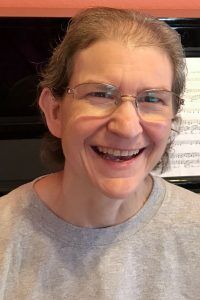Why write a Pride hymn? My answer begins with a parable and some commentary.
And he spoke to them and said, “What is the Community of God like? It is like a Pride parade filled with a great diversity of people, decked out in rainbows and beads and drag, marching down Fifth Avenue in New York City, twirling batons, roller skating.
And among the marchers is a young man whose parents threw him out. This is his first Pride parade. He sees protesters on one corner and he is filled with terror and shame. But he keeps marching.
And on the next corner, he sees a group of older men and women holding a huge banner reading, ‘Free Mom Hugs! Free Dad Hugs!’ His eyes meet the eyes of one of the older men, and the man holds out his arms and beckons the young man over.
The young man falls into the older man’s arms, sobbing. They embrace for a long time. Then several other men and women from the group take over, hugging the young man into joy and gratitude and connection.
This is what the Community of God is like. All who have been exiled will come home, all who have been judged will be loved without condition, all who have been oppressed will be free, and all who have been excluded will be welcomed. Behold, this is the good news!”
Jesus didn’t actually offer us that parable, of course. But if he were here today, he just might, especially if he were teaching a bunch of LGBTQ+ people.
Jesus was a genius at coming up with parables that reached people where they were but then took them someplace else, someplace new, by juxtaposing the familiar and mundane with the ridiculous and unthinkable, the ho-hum and ordinary with the uncomfortable and barrier-breaking.
Some people might be tempted to see the protesters in my parable as similar to the Pharisees because Jesus condemns them in Matthew’s Gospel. However, we know that the invective Matthew puts in Jesus’s mouth about the Pharisees represents not Jesus’s own words but the struggle within Judean Judaism at the time Matthew was writing, an intra-family struggle that was all the more bitter for being so very close to home. It is, therefore, not helpful to compare the protesters to the Pharisees.
Perhaps instead we can compare the young man’s response to the protesters to the temptations of Jesus in the desert.
For those cast out by their families, self-hatred and self-doubt are serious temptations. For those raised to believe that “God Himself” is homophobic, worshipping an unloving god may be a temptation (though it is by definition idolatry, since any unloving god is not the true Holy One).
For those enculturated in violent, shame-driven forms of religiosity, the temptation to trust what is ultimately untrustworthy must be powerful. But our young man resists temptation, and indeed, when he does, angels come and minister to him in the form of a group of ally parents.
In resisting these temptations, our young man is practicing repentance, turning away from shame and self-hatred and turning toward love and joy. He is practicing true humility, in which honest self-love casts out humiliation. In jettisoning vigilance for vulnerability, he is remaining open to the good news that Jesus taught and lived.
Pride celebrations represent some of what is best about humanity. They, and the communities they lift up, merit gratitude and hymns of praise. Which brings me to my Pride hymn, “Days of Rage and Days of Hope.”
I wrote the hymn in 2019 when I learned that there was a need for such pieces. I structured the verses carefully to capture and celebrate the original event of Stonewall, the struggles and successes of the LGBTQ+ community/communities since then, and the gifts and joy we LGBTQ+ people bring the world today. Each verse ends with the lifting up of thanks for our good gay/queer/bisexual/trans/lesbian/gender-fluid/non-binary/otherwise variant lives.
As a bisexual person and a sociologist, I struggled with the “born that way” phrase but I think enough people find that self-understanding meaningful that it was reasonable to leave in the lyric. I chose to leave doctrinal language out of the text to make it accessible to a broader range of religious communities.
I set the text to fairly traditional European-inspired hymn music with (what I hope is) a fairly singable melody. Sheet music is freely available on my website, Queer Sacred Music, where you can also find scores, recordings, and videos of about a hundred original free-use inclusive hymns, worship songs, and rounds.
Peace, grace, and Happy Pride!

A hymnwriter, songwriter, composer, and writer who specializes in music and lyrics for liberal/progressive religious people and communities — including inclusive, social justice-minded Christians, Unitarian Universalists, and other open-hearted religious traditions — Amanda Udis-Kessler maintains the website Queer Sacred Music.
